Advertisement
Fight the winter blues by paying your boat a visit and making sure all is well. Whether it's stored on the hard or in the water, you may just forestall some spring problems.
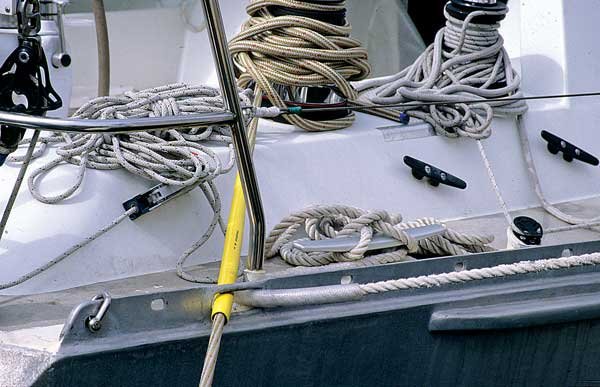
Chafe guards will keep your lines from shredding.
This is the time of year when you can't help wondering if winter will ever end. The days don't seem to be getting any longer, and the sun barely climbs high enough to provide a bit of warmth before slinking back down to the horizon. As the sound of water lapping against the hull and the feel of a cool breeze tickling your face fade into fond memories, it's easy to settle into a midwinter funk. Shake off those winter blues by visiting your boat. Better yet, organize a rendezvous with boating buddies near your marina so you can swap some sea stories after making sure your boats are weathering the winter without problems. Not only will reminiscing about summer help get you through the winter doldrums, but a thorough midwinter inspection that uncovers some developing problems may well get you back on the water faster in the spring.
The Walk-Around (Boat On Water)
Take a close look at the waterline.
Is there a change? If the boat looks lower on its lines than the last time you saw it, or if it's down at the bow or the stern, check for water in the bilges when you get aboard.
Check docklines along their entire length for security and any signs of chafe.
Adjust the chafe guards if necessary (heavy hose, fire hose, or commercially made chafe guards will keep your lines from shredding during bad weather). Smaller boats can get caught under a dock at low tide and then be overwhelmed by the rising tide and sunk.
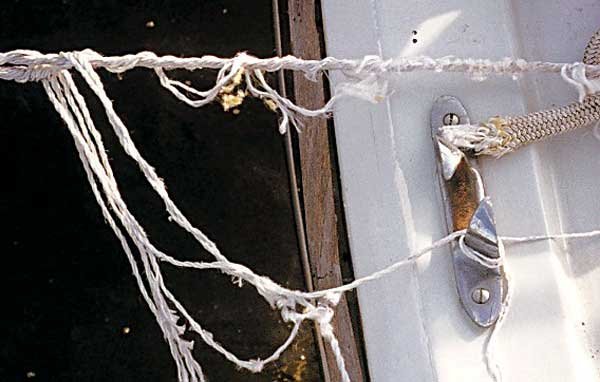
Good chafe protection can prevent shredded lines.
Make sure docklines are tight enough to keep the boat off the dock, but loose enough to allow for variations in water level.
Make sure your fenders haven't wandered.
Look for any marks on the hull that might signal a problem that occurs only at low or high tide or in high winds. Fenders that are tied to lifelines tend to slide around and bend stanchions — attach them to cleats or the toe rail if possible.
Are all above-water thru-hulls still above water? The weight of snow and ice can submerge above-waterline thru-hulls, including the exhaust. If any are underwater, start shoveling.
Inspect the shore-power cord.
Inspect from the dock pedestal to the inlet on your boat. Look for flat spots, kinks, or chafe marks where the cord may have gotten pinched between the boat and dock, or corrosion on the plug's blades. Either can cause overheating and lead to fire. Make sure the cord can't get into the water or get crushed against the dock. And don't leave a heater plugged in when the boat is unattended; that's a leading cause of fires in the winter.
Secure your wheel or tiller.
Prevent rudder damage from boat movement.
The Walk-Around (Boat On Land)
Minimize theft.
If your boat is stored on a trailer, make sure the tongue is facing away from the road. Ideally, the wheels should be removed, and the trailer should be up on blocks. Not only will that discourage thieves, but your tires will last a lot longer.
Check the jackstands, cradle, or trailer.
Make sure the boat hasn't shifted. Boats over 26 feet in length should have at least three jackstands per side. The boat should be level so that water drains properly out the scuppers and doesn't cause stains, or worse, leaks down below. Verify that jackstands have been properly positioned and chained together to prevent them from being pushed away from the boat. There should be jackstands at the boat's bulkheads and supporting the bow. Look down the hull and make sure that there is no deformation at the jackstands.
Make sure the cover hasn't been tied off to the jackstands.
A strong wind could get underneath the cover and yank the jackstand out from under the boat. If the boat is stored on dirt or gravel, the jackstands should have plywood under them to keep them from sinking into the ground. If you see any problems with a jackstand, don't try to adjust it yourself; contact marina personnel.
The Walk-Through
Once you're satisfied that the boat is well secured in its slip or on the hard, get aboard and stroll from one end of the boat to the other, on deck and below. Here's what to look for:
Examine your boat cover.
Look for the beginnings of tears, loose fittings, and chafe, and make sure the wind hasn't broken a tie-down line. Verify that all supports for the cover are still in place and in no danger of shifting; any cover that isn't well-supported will accumulate snow and water, which add considerable weight to the boat. If the boat is shrinkwrapped, even relatively large tears can be fixed with duct tape.
Look for any pooling water on the deck or in the cockpit.
Standing water can stain the boat, damage gelcoat, and seep under fittings to cause delamination problems. If your boat doesn't have a cover and is stored on the hard, get rid of the water as soon as possible (use rock salt if the water is frozen). Ask marina personnel to level the boat by adjusting the jackstands.
Check cockpit scuppers and drains for blockage.
Boats stored in the water are sunk each year because leaves or snow prevented water from draining. Boats stored ashore can flood when pooled water pours from the cockpit into the interior.
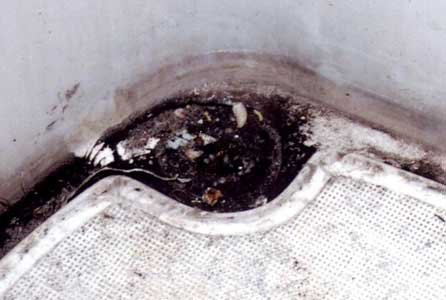
Leaves can block scuppers allowing water to collect in the cockpit.
If your boat's on a trailer, make sure your hull drain plug is out, the drain hole isn't clogged, and the bow is up so any water that finds its way below will get out again.
Check that halyards have been securely tied off if the mast was not unstepped.
Slapping halyards leave scars on the mast and drive anyone in the vicinity crazy. If you haven't done so already, remove roller-furling headsails to reduce windage. If your sails need cleaning, send them off to the sailmaker.
Does the boat smell moldy?
There could be a portlight or hatch leak. Other smells, such as gasoline, propane, or vermin, need to be investigated right away. If you leave your 12-volt or AC electrical system on (the only things that should be on over the winter are the battery charger, bilge pump/highwater alarm, and smoke alarms), sniff for any electrical odors.

Covers that do not allow air circulation around the hull can cause paint blisters.
It's possible that a circuit could be overloaded or shorted, or the battery is being overcharged. Find the source.
Make sure the boat is well-ventilated.
Air circulation prevents mold and mildew from forming down below and keeps the boat smelling fresh. Covers should have ventilation ports to allow air to circulate; leaving a hatch or portlight in the head compartment cracked open a tiny bit will bring that air inside the boat. If your topsides are painted, air also needs to be able to circulate between the cover or shrinkwrap and the boat to avoid blistering. If you don't have a cover, take the opportunity to open several hatches and ports while you're visiting to circulate fresh air below.
If you encounter mold or mildew, ignoring it can result in serious damage to the interior. Wipe down mildewed surfaces with any one of several commercial products or a 50/50 solution of white vinegar and water. (If the problem recurs frequently, add a solar ventilator when the weather breaks.)
Open lockers to circulate air and leave them open.
Tilt cushions up or, better yet, take them home. Cushions tend to retain moisture, which makes them smell funky and creates mildew problems.
Check portlights and hatches for leaks.
Look for water stains. Green corrosion, dirt streaks, black caulk, or water trails around a portlight or hatch are all early warning signs to be taken seriously. If you're lucky, the hatch or portlight wasn't dogged down properly, but it's more likely you'll be replacing the gasket or recaulking the opening come spring.
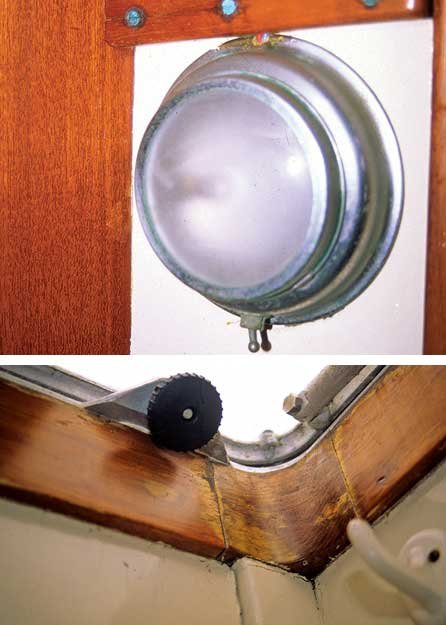
Green corrosion or discoloration of hatch surrounds means you have a leak.
In the meantime, duct tape will help to keep water out (use paint thinner to remove tape residue in the spring). Canvas or a heavy plastic tarp can also be rigged to cover the opening and keep the boat drier.
Inspect your bilge.
No good ever comes from water in the bilge, and any water means a leak. Hopefully you've already found the source of the water during your walk-through, but if not, try to figure it out and put a stop to it before leaving your boat again.
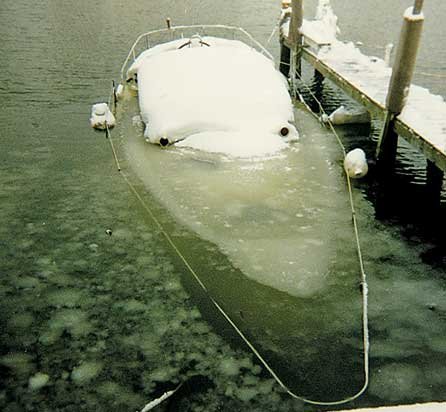
Check your hoses, scuppers, and stuffing box to be sure your boat doesn't end up like this.
If your boat's on the hard and you're in a cold climate, you may well be looking at ice in the bilge. Use rock salt and nontoxic antifreeze to break it up, dry the bilge completely, and, to keep it from refreezing, add a few cups of nontoxic antifreeze.
Check the operation of the bilge pump and float switch.
If you've left a battery onboard, make sure the bilge pump works with the battery master switch in the OFF position.
Open and close each seacock a couple of times to keep them from seizing.
If your boat is in the water, make sure that all seacocks are closed (with the exception of cockpit drains); many a cracked or slipped hose has sunk a boat. If your boat is on the hard, now's a good time to take sticky seacocks apart for servicing.
The Down and Dirty
Before you tuck your boat back in for its winter's nap, take a quick look around the engine compartment and at the batteries.
Look for swollen or cracked hoses.
Check for rusted or broken hose clamps, and chafed or melted wires. Give wire and hose connections a tug -- better to have them come apart now than while you're not around. If you have a generator, check the fittings.
Look for any fuel, oil, or cooling-water leaks.
You don't want your bilge pump to spew oil into the water next spring; in addition to polluting the environment, you could be in for a big fine.
If your boat is in the water, check to make sure that water in the bilge isn't coming from your stuffing box; leaking stuffing boxes sink boats every year. A stuffing box should not drip at all when the engine is not running.
Examine the bellows.
Fflexible rubber connections that seal the outdrive and cables passing through the boat on your sterndrive if you have one. Look for cracks between the folds and check for a trail of water from the bellows to the bilge.
Inspect battery terminals for corrosion.
Top off the battery with distilled water (if you have conventional wet cells). If you have a multimeter, check the state of charge; 12.6V is typically fully charged, but the voltage can be as high as 13.8V if attached to a charger. If you're plugged in to shore power, make sure your battery charger is the kind that turns off when the battery is topped up to prevent overcharging. Most automotive chargers don't work that way, and they're not ignition protected, which means they could spark a fire from a fuel leak.
When you've finished your inspection, don't forget to close and lock all ports, hatches, and the companionway to prevent theft. Then go have a nice, long lunch with your boating buddies and tell a few sea stories. If you visit your boat once or twice a month, not only will the winter go by more quickly, but you'll rest more easily when the last few storms of the season start rattling the windows.
BoatUS Members save at Boat Shows
Make sure to mark your calendars for two exciting events – the New England Boat Show, Chicago Boat Show, and Atlanta Boat Show. Don’t miss out on these incredible shows! BoatUS Members save 25% with code BOATUS25.
Here are the dates for each show:
